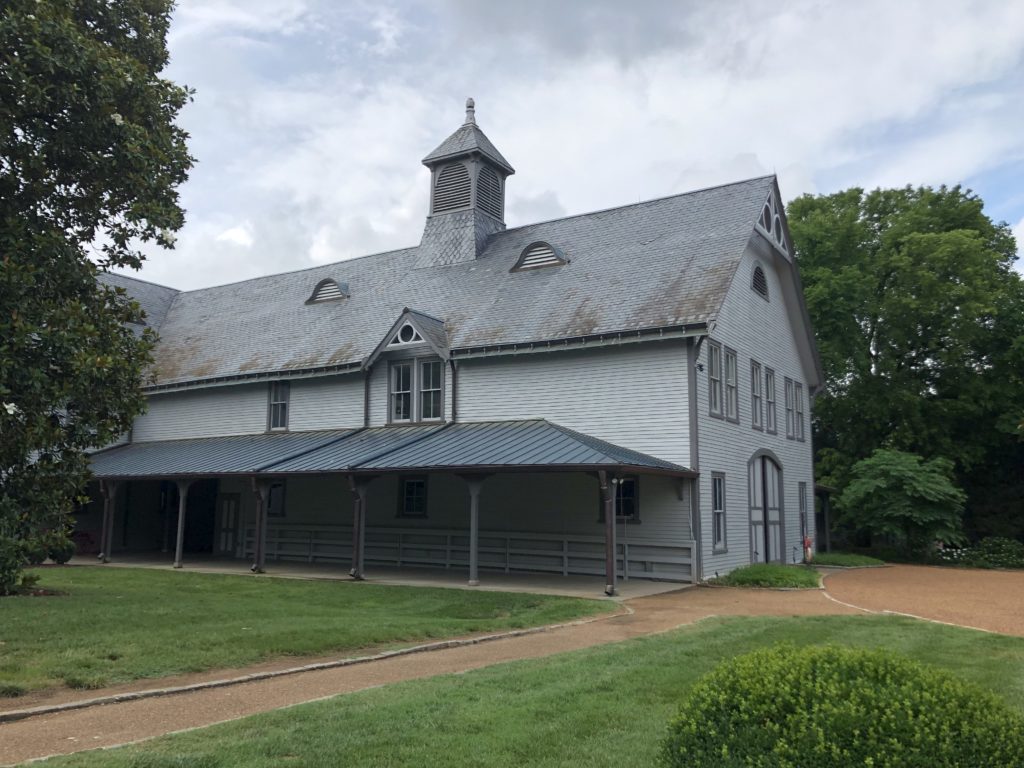Twice in the past month I’ve had the fun of visiting two southern plantations: Boone Hall outside Charleston, South Carolina, and Belle Meade outside Nashville, Tennessee. While they don’t quite fit the definition of ruins, they get me in the heart all the same.
It was my third trip to Charleston. Both previous times I toured other antebellum homes before running out of time for Boone Hall–even though I’ve always been drawn to it. It’s possibly one of the most well known plantations by sight. The iconic long drive beneath the canopy of live oaks makes it the perfect setting for TV and movies. The long-ago miniseries North and South was filmed there, as were several others.

The biggest surprise of Boone Hall was that the main house is the third structure on that spot, and it wasn’t built until the twentieth century–not antebellum at all. I will admit to feeling a little disappointed by that fact!
However, a tour of the slave cabins made up for it as far as heart tugs. This part of any plantation tour never fails to bring mixed feelings, and these cabins hold extra-special details. Being brick, they were high-end for the laborers who lived in them, but still a far cry from the main house. House workers lived in them, and they were built in a row lining that famous driveway as a way for the plantation owner to show off his wealth and “property.” My emotions lingered there longer than in the main house.


The most memorable detail for me were the fingerprints in the bricks of the slaves who were forced to build their own residences of captivity. I can still feel the gritty mortar against my fingertips. A real person with a real day-to-day life left those marks of remembrance.
Belle Meade Plantation

To capture the aura of Belle Meade Plantation outside Nashville, think horses, horses, and more horses. And not just any old horses, but only the best. This was a premier horse-breeding stud farm in the 1800s. My husband and I both loved this place! We really had no clue what we were walking into when we decided to venture to this part of Nashville.
The 45-minute house tour was chock full of interesting details. We were there the day after the Belmont Stakes race–the third of the famous Triple Crown each spring. The first thing the tour guide asked us is whether anyone had heard of Bonnie Scotland. No one had, and she wasn’t surprised. But she went on to say that we’ve all probably heard of Bonnie Scotland’s offspring, as well as the many prestigious offspring sired there by Iroquois, whom at his death was called the most famous thoroughbred of all time. Dozens of winners of the Kentucky Derby, Preakness, and Belmont races trace their lineage to Belle Meade. Some even earned the coveted title of Triple Crown winner. You’ve heard of Secretariat, Seabiscuit, Barbaro, California Chrome, Man-O-War, War Admiral, Seattle Slew, to name only a few. This is that place.

munching grass and taking it easy with a friend
We even saw Seattle Slew’s grandson, Jester. He is the chestnut in the picture above. Even a novice like me can see the breeding and power in his lineage–veins and muscles bulging all over his body. He didn’t have the time of day for us, although his friend came up to the fence to visit.
A general history: Belle Meade was home to the Harding/Jackson families–no relation to presidents, although it hosted several. Founded in 1807 along the Natchez Trace, it was a prime location for travelers to have their horses shod. The original cabin is still there, as well as the carriage house and stables, a slave cabin, and a number of other buildings. Visitors can tour the mansion and grounds, as well as a slavery tour called Journey to Jubilee, and a tour of the winery that includes free wine tasting. And my husband couldn’t say enough good things about his Smokehouse Cabin sandwich at lunch at the Harding House Restaurant. It was scrumptious.


This place is beyond amazing. Its heyday lasted a mere hundred years. But its legacy continues. It’s my favorite plantation visit so far. Although I could go on and on, this post probably shouldn’t! But no overview of it would be respectable without a nod to the skilled freedman who truly made this place what it is–and made American horse history what it still is today.
The Harding/Jackson families may have had the money and connections, but Bob Greene had the skills to know how to breed winners time after time. He was widely respected in social circles beyond what were viewed as his own back then. Without him, Belle Meade would not have become all it was. And the world may not have heard of the horses named above–and so many more–that still dominate the top ranks of horse racing.

Bottom: Iroquois
This is a must see that makes me wish I lived closer so I could drag all my friends here to show them just how fascinating it is. If you have the time, do spend a few minutes reading more about Belle Meade. Even better–just go see it.

